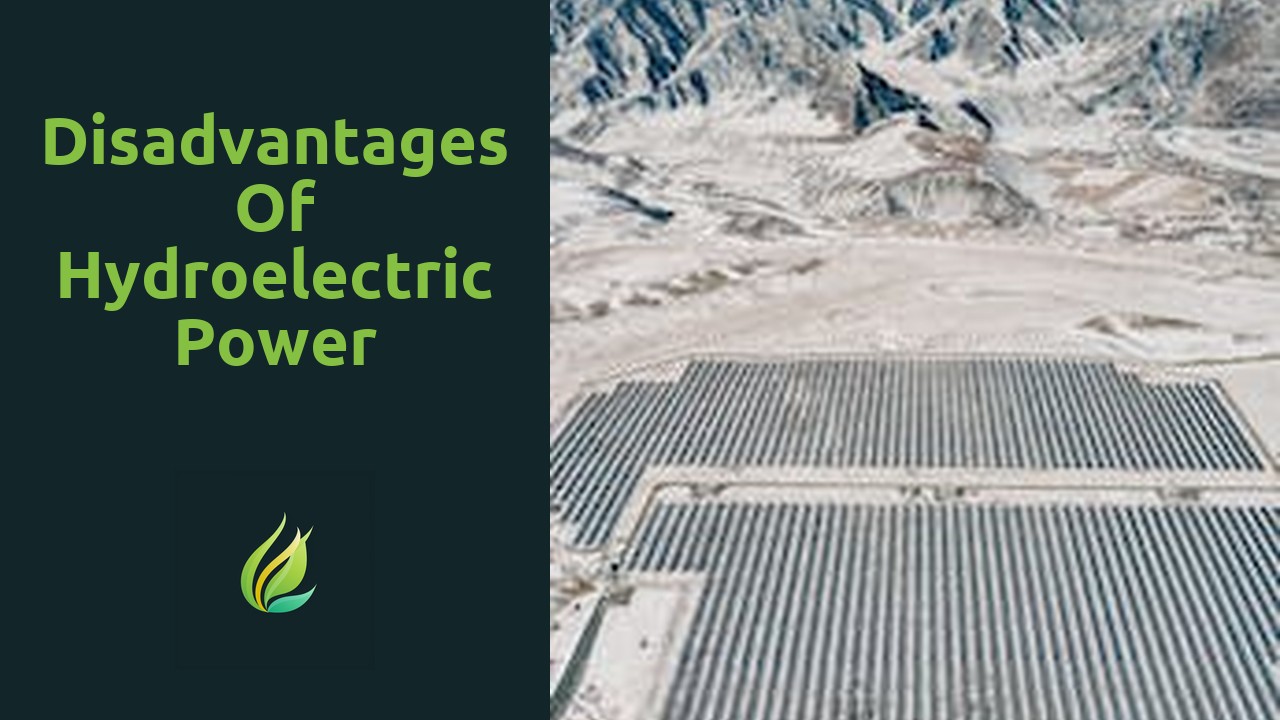Disadvantages of Hydroelectric Power

Effects on Fish and Aquatic Life
The construction of hydroelectric power plants can have significant effects on fish and aquatic life. The alteration of natural river flow can disrupt fish migration patterns, making it difficult for them to reach their spawning grounds. The dams themselves can also pose obstacles, preventing fish from swimming upstream or downstream. This can lead to declines in fish populations and have a detrimental impact on the overall aquatic ecosystem.
Furthermore, the operation of hydroelectric power plants can result in changes to water temperature and quality. The release of water from the reservoirs can cause fluctuations in temperature, which can negatively affect the reproductive cycles and survival rates of fish species. Additionally, the accumulation of sediment behind the dams can lead to decreased oxygen levels in the water, making it less suitable for fish and other aquatic organisms. These changes in water quality can have far-reaching consequences, impacting not only fish populations but also the entire food chain within the aquatic ecosystem.
Displacement of Communities and Indigenous People
Communities and indigenous people are the silent victims of large-scale development projects that emerge as a consequence of our constant reliance on energy. As these projects are carried out, entire communities are uprooted from their ancestral lands, forced to abandon their homes and way of life. The impact of this displacement extends far beyond the physical relocation; it disrupts social dynamics, cultural practices, and traditional knowledge systems that have been passed down for generations. It is a painful erasure of identity and heritage, leaving individuals and communities disoriented and disconnected from their roots.
Moreover, the displacement of communities and indigenous people not only affects their immediate well-being but perpetuates a cycle of marginalization and vulnerability. Often, these displaced populations are pushed into overcrowded and impoverished areas, lacking access to basic services such as healthcare, education, and employment opportunities. The loss of their livelihoods and social networks further compounds their struggles, leading to increased poverty, inequality, and in some cases, social conflicts. In the pursuit of energy generation, it is vital that we acknowledge and address the significant consequences faced by these communities, ensuring that their rights, cultures, and voices are not disregarded in the face of progress.
Loss of Natural Habitats
The construction of large dams has been a significant contributor to the loss of natural habitats. The flooding caused by the dams not only submerges vast areas of land but also alters the natural flow of rivers. This disruption disrupts the ecosystems that are dependent on the rivers, leading to the displacement of various plant and animal species. The underwater plants and vegetation that once thrived in these habitats are now suffocated, leading to a decline in biodiversity. Additionally, the altered flow of water affects the migration patterns of fish and other aquatic species, further impacting the delicate balance of these ecosystems.
Furthermore, the submersion of forests and wetlands due to dam construction has severe consequences for wildlife populations. These natural habitats are often home to numerous species of plants and animals, many of which are rare or endangered. As these habitats are flooded, the animals are forced to relocate or perish. The loss of these natural habitats not only disrupts the delicate ecosystems but also threatens the survival of various species. The destruction caused by dam construction is irreversible, and once these habitats disappear, they cannot be replaced easily. The loss of natural habitats due to dam construction is not only an environmental tragedy but also a potential threat to the long-term sustainability of our planet.
Inconsistent Power Generation
One major concern with renewable energy sources such as wind and solar is the issue of inconsistent power generation. Unlike traditional forms of energy generation, which can operate consistently throughout the day, renewable energy sources are heavily reliant on external factors such as weather conditions and daylight availability. This means that there can be significant fluctuations in the amount of power that is produced, making it challenging to maintain a stable and reliable energy supply.
This inconsistency in power generation can pose several problems for the overall energy infrastructure. For instance, during periods of low wind or cloud cover, there may be a significant drop in the amount of electricity being generated. This can result in blackouts or power interruptions, impacting both residents and businesses. Additionally, the inability to consistently generate power can also lead to increased reliance on traditional energy sources, such as fossil fuels, to meet the energy demands during these periods of low renewable energy production. This not only undermines the goal of transitioning to clean energy but also contributes to environmental degradation and air pollution.
High Initial Costs
Building a hydroelectric power plant comes with its own set of challenges, one of which includes the high initial costs involved. These costs arise due to the need for extensive planning and engineering, as well as the construction of dam infrastructure. The expenses also take into account the installation of turbines and generators, which are necessary for converting the potential energy of water into electricity. Additionally, there are significant costs associated with obtaining the necessary permits and conducting environmental impact assessments. All these factors contribute to the overall high initial costs of hydroelectric power plants.
Despite the financial burden they pose, it is important to acknowledge that the long-term benefits of hydroelectric power plants often outweigh these initial costs. Once the infrastructure is in place, the cost of generating electricity is relatively low compared to many other forms of energy production. Moreover, hydroelectric power is a renewable energy source, meaning it is sustainable and does not deplete natural resources. Ultimately, while the high initial costs of hydroelectric power plants may be daunting, it is crucial to consider the long-term advantages they bring in terms of clean and affordable energy production.
Related Links
Environmental Benefits of Hydroelectric PowerAdvantages of Hydroelectric Power
All there is to know about foam injection molding Manufacturing
Comparison of Biomass Power Plants to Other Clean Energy Sources